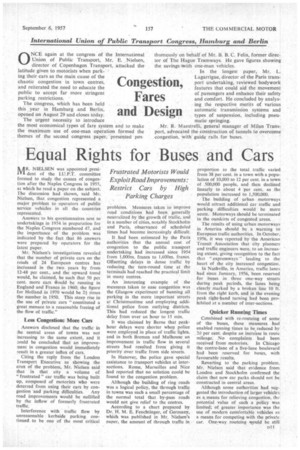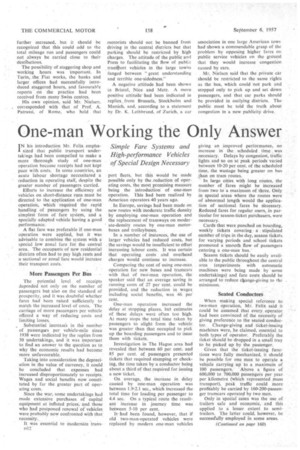Equal Rights for Buses and Cars
Page 57

Page 58

If you've noticed an error in this article please click here to report it so we can fix it.
!UR. NIELSEN was appointed presi
IVI dent of the committee formed to study the causes of congestion after the Naples Congress in 1955, at which he read a paper on the subject. The discussion had shown, said Mr; Nielsen, that congestion represented a major problem to operators of public service vehicles in all the countries represented.
Answers to his questionnaires sent to undertakings in 1954 in preparation for the Naples Congress numbered 47, and the importance of the problem was indicated by the fact that 86 answers were prepared by operators for the latest paper.
Mr. Nielsen's investigations revealed that the number of private cars on the roads of 24 European centres has increased in the two years by from 12-48 per cent., and the upward trend would, he claimed, be such that 50 per cent, more cars rkould be running in England and France in 1960; the figure for Holland in 1970 would be 24' times the number in 1950. This steep rise in the use of private cars "constituted a great menace to a reasonable freeing of the flow of traffic."
Less Congestion: More Cars Answers disclosed that the traffic in the central areas of towns was not increasing to the same extent, and it could be concluded that an improvement in congestion would immediately result in a greater influx of cars.
Citing the reply from the London Transport Executive as showing the crux of the problem, Mr. Nielsen said that in that city a volume of " fnistrated " car traffic was being built up, composed of motorists who were deterred from using their cars by con
gestion 'and parking difficulties. Any road improvements would be nullified by the inflow of formerly frustrated
traffic. • Interference with traffic flow by unreasonable kerbside parking continued, to be one of the most critical problems. Measures taken to improve road conditions had been generally neutralized by the growth of traffic, and in a number of cities, notably Stockholm and Paris, observance of scheduled times had become increasingly difficult.
It had been estimated by the Paris authorities that the annual cost of congestion to the public transport undertaking had increased since 1954 from 1,000m. francs to 1,600m. francs. Offsetting delays in dense traffic by reducing the turn-round time at the terminals had reached the practical limit in many centres.
An interesting example of the measures taken to ease congestion was the Glasgow experiment of banning all parking in the more important streets at Christmastime and employing additional police from outlying districts. This had reduced the longest traffic delay from over an hour to 15 min.
It was claimed by Berne that peak' hour delays were shorter when police were employed in place of traffic lights, and in both Bremen and Mulhouse an improvement in traffic flow in several streets had resulted from giving it priority over traffic from side streets.
In Hanover, the police gave special assistance to transport vehicles at intersections. Rome, Marseilles and Nice had reported that no solution could be found to the congestion problem.
Although the building of ring roads was a logical policy, the through traffic in towns was such a small percentage of the normal total that by-pass roads would not give relief to the centres.
According to a chart prepared by Dr. H. M. E. Feuchtinger, of Germany, which was published in Mr. Nielsen's paper, the amount of through traffic in proportion to the total traffic varied from 38 per cent, in a town with a population of 10,000 to 12 per cent, in a town of 500,000 people, and then declined linearly to about 4 -per cent, as the population increased to 1,500,000.
The building of urban motorways would attract additional car traffic and parking difficulties would be more acute. Motorways should be terminated in the outskirts of congested areas.
The results of using urban motorways in America should be a warning to European traffic authorities. In October, 1956, it was reported by the American Transit Association that city planners and traffic engineers were, to an increasing extent, giving recognition to the fact that "expressways leading to the heart of the city increased congestion.
In Nashville, in America, traffic lanes had since January, 1956, been reserved for buses in three one-way streets during peak periods, the lanes being clearly marked by a broken line 10 ft. from the right kerb, and in the evening peak right-hand turning had been prohibited at a number of inter-sections.
Quicker Running Times Combined with re-routeing of some of the buses, these measures had enabled running times to be reduced by 20 per cent, despite an increase in route mileage. No complaints had been received from motorists. In Chicago the centre-lane of a five-lane boulevard had been reserved for buses, with favourable results.
Reverting to the parking problem. Mr. Nielsen said that evidence from London and Stockholm confirmed the claim that new car parks should not be constructed in central areas.
Although some authorities had suggested the introduction of larger vehicles as a, means for relieving congestion, the potential value of such a policy was limited; of greater importance was the use of modern comfortable vehicles as a means for competing with the private car. One-way routeing would be still further increased, but it should be recognized that this could add to the total mileage run and passengers could not always be carried close to their destihations.
The possibility of staggering shop and working hours was 'important. In Turin, the Fiat works, the banks and larger offices had successfully introduced staggered hours, and favourah'e reports on the practice had been received from many Swiss centres.
His own opinion, said Mr. Nielsen, corresponded with that of Prof. A. Patrassi. of Rome, who held that motorists should not be banned from driving in the central districts but that parking should be restricted by high charges. The attitude of the public and Press to facilitating the flow of publ.e traneort vehicles in the large towns fanged between " great understanding and terrible one-sidedness."
A negative attitude had been shown in Bristol, Nice and Metz. A more positive attitu'cle-had been indicated in replies__ from Brussels, Stockholm and Munich, and, according to a statement by Dr. K. Leibbrand, of Zurich, a car
association in one large American town had shown a commendable grasp of the problem by opposing higher fares oil public service vehicles on the ground that they would increase congestion caused by ears.
Mr. Nielsen said that the private car should be restricted to the same rights as the bus, which could not park and stopped only to pick up and set down passengers, and that car parks should be provided in outlying districts. The public must be told the truth about congestion in a new publicity drive.




























































































































